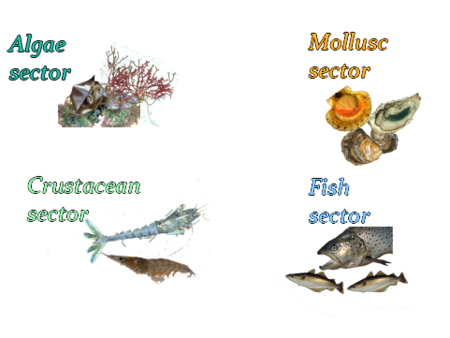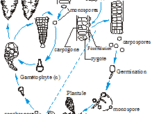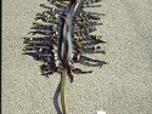Macrophytes
Name : | macroalgae, |
|---|---|
Scientific name : | Nori: Porphyra sp |
Size : | 30cm-60cm Europe |
1m50-3m Europe |
20cm-30cm Europe |
30cm-50cm Europe |
30cm-50cm Europe |
20cm-40cm Europe | 30cm-40cm Antilles Djibouti |
History: from the pioneers to today …
Unlike Asian countries where algoculture covers large surface areas, Europe uses mainly manual methods to meet the needs of the market.
A number of species have been submitted to cultivation tests, based on the development of human food applications and specific parapharmaceutical applications. These two domains demand products with stable qualities, and they make it possible to yield higher margins than those obtained in the industrial sector based on phycocolloids.
Culture techniques and production cycle
In marine vegetables, reproduction can take two forms : sexual or vegetative. Algae are often able to use either form depending on the conditions of their environment.
The different cultivation techniques employed – with various levels of complexity - take advantage of this feature. The seedlings are often cultivated on a substratum (cords, ropes, nets, pieces of rock), which must be seeded on a regular basis. The cuttings techniques consist of periodically inserting sprigs of algae between the strands of the ropes that are suspended into the sea (Gracilaria, Palmaria), or of tying them to a fine thread (Kappaphycus), or even of seeding the nets with crushed alga pulp (A sparagopsis).
Algae can also be cultivated inside bladed wheel agitated “raceway” type tanks (Chondrus), or inside low pressure intense bubble agitated tanks ( Gracilaria, Palmaria).
For other species, sexual reproduction mode proves more interesting to ensure efficient seeding of the cultivation systems:
- Refer to the sheet on Undaria pinnatifida for the laminarial species.
- The Laver cultivation is one of the most elaborated techniques.
Its cycle –relatively complex – is now well mastered, and this makes it possible to achieve high yields and exceptional quality products.
Product value enhancement
Whereas the brown algae of the laminarial families can be consumed raw, red algae must often be dried beforehand.
As a food element, alga enjoys the reputation of being a probiotic product which promotes the organism defences, compensates for mineral salt deficits thanks to generous input thereof, and also of being significantly rich in vitamins.
Active ingredients – which promote the utilization of silicium by the organism – are extracted from the red alga Asparagopsis armata.
Kappaphycus alga produce phycocolloids used mainly for human consumption in dairy products.
Economy
Whereas at the European level the potential for alga cultivation seems high, effective implementations are still hindered by numerous unexpected factors that make it difficult to ensure the perenniality of the businesses that dare entering this industry. Markets are either too small to absorb the production, or too large for the production capacities.
The distribution of food products is often anecdotal, or limited to specialized outlets (macrobiotic or vegetarian shops), or even associated with the presence of an Asian population used to this type of food.
Strengths / Weaknesses
Strengths | Weaknesses |
|---|---|
|
|



